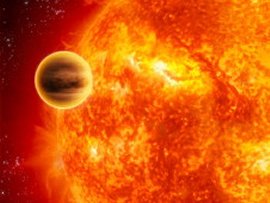NASA's new Kepler space telescope, whose mission is to hunt for planets, has discovered the atmosphere of a gas giant, demonstrating the telescope's extraordinary scientific capabilities. The finding will be published today, Friday, in the journal Science.

NASA's new Kepler space telescope, whose mission is to hunt for planets, has discovered the atmosphere of a gas giant, demonstrating the telescope's extraordinary scientific capabilities. The finding will be published today, Friday, in the journal Science.
As NASA's first planet-searching mission, Kepler made an impressive entry, says John Morse, director of the Science Mission Directorate at NASA Headquarters in Washington. "Discovering the atmosphere of this planet in just the first ten days of examining the data is just a taste of what's to come. The planet hunt is on.
The telescope was launched on March 7, 2009 from Cape Canaveral and will spend three and a half years searching for small planets - around the size of Earth, including those orbiting their suns in the habitable zone. "We may be able to detect water, the spacecraft will be able to do this through observations of periodic decreases in the brightness of the stars that will appear when the planet passes between us and the star.
When the light curve from the tens of thousands of stars photographed at the same time reached the telescope's scientific team everyone was excited. No one has ever seen such detailed measurements of the light variation of so many types of stars, says William Brookey, the telescope's principal scientific investigator and lead author of the paper.
The observations were collected from a planet known as HAT-P-7, a planet discovered by the transit method, and which is about a thousand light years from Earth. The planet orbits it in a total of about two days (2.2 days) and is 26 times closer to its star than Earth is to the Sun. Its orbit combined with the mass showing that it is somewhat larger than the planet Jupiter, classifies the planet as a hot Jupiter. "It is so close to its star that it is as hot as a red light shining on a kitchen stove."
The new Kepler data can be used to study hot planets in a detail that was not possible until now. The depth of the obscuration and the shape and slope of the light curve show that the planet has an atmosphere that is brown on the day side about 2,380 degrees Celsius. A little of this heat goes to the night side. The eclipse time compared to the prime transit time shows that the planet has a circular orbit. The discovery of the light from the planet confirms the predictions made by scientists who used theoretical models that the emissions would be possible to detect by Kepler.
The observed brightness is only one and a half times that expected for a transit caused by a planet the size of the Earth. Although this is the greatest accuracy achieved so far in observing this planet, Kepler will be able to provide much more precise details after the analysis software developed for the mission is completed.
"These early results show that Kepler's sensor system is doing its job." says David Koch, deputy principal investigator at NASA's Ames Center in California. "We are now confident that with this level of precision, Kepler will also be able to discover planets similar to Earth."

17 תגובות
What is the atmosphere of a gaseous planet?
Most of the planet is atmosphere, with the possible exception of a small iron core.
Black suits in Mitzpe Ramon? Isn't it too hot like that?
….people from the administration…. 🙂
Ronan:
A UFO is an unidentified object.
The less you know, the easier it is not to recognize an object.
I believe in response 5. There are people from Mitzpe Ramon who are willing to swear that they saw a UFO and I am their son
Nibiru?
refresh hello,
In addition to your question: is it relevant for us, if the Kepler telescope discovers a planet with conditions like the planet "Earth", when its distance from us is millions of light years. After all, what we learn from this information is what happened millions of years ago. Maybe his sun ran out of "fuel" and this planet ended its life? Yoram
White blood, are you sure you're not some kind of angel in our case?? White blood..well come on..:)
Well, it's better to see aliens than to see angels or God or Elijah the prophet...
Government officials in black suits?
Straw man, better to ask him what he took before he saw them 😛
Another troll 😐 don't comment.
And I'm not saying that for nothing, I'm not influenced by websites of any kind. I saw myself in luck when I visited my girlfriend in Mitzpe Ramon and they were really close to me. Also, government officials came out of nowhere and pushed me away
oak:
You suggest to stop with the nonsense and then immediately continue with the nonsense.
enough with the nonsense the governments know and are aware of the aliens who visit us and probably know where they came from
fresh:
Write knowing that the star's atmosphere has been detected.
It is much more than the identification of a star.
The problem is that Jupiter-like planets are indeed detectable with today's technology, but what you really want to look for is planet Earth with conditions for life (as we know it) and today's technology still does not allow that.